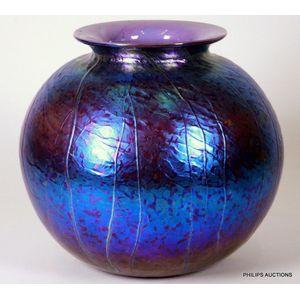Iridescent Glass Vase by Colin Heaney (1989)
You must be a subscriber, and be logged in to view price and dealer details.
Subscribe Now to view actual auction price for this item
When you subscribe, you have the option of setting the currency in which to display prices to $Au, $US, $NZ or Stg.
- Oviform /ovoid - The outline loosely resembling the shape of an egg.
- Irridescent Glass - Iridescent glass has a shimmering or rainbow-like appearance due to the way it reflects light. It is created by applying a thin layer of metal oxides to the surface of the glass while it is still hot and malleable, which then creates an interference effect that produces a range of colours as the light reflects off the surface. The exact colours and patterns created by iridescent glass depend on the specific types of metal oxides used and the techniques used to apply them.
Iridescent glass was first developed in the late 19th century, and quickly became popular for use in decorative art glass and stained glass windows. Some of the most famous examples of iridescent glass were created by artists such as Louis Comfort Tiffany and his studio, who used it extensively in their distinctive lamps, vases, and other decorative objects. - Everted - An everted rim is an outwardly turning or flaring outwards rim, as seen the rims on jugs, vases, bowls and dishes.
- Etched - Glass decorated with an etched design, which is achieved through marking out the pattern, protecting the area that is not be etched, and then immersing the object in acid to dissolve the surface of the unprotected area. With some glass objects, such as cameo glass, there may be several layers of different coloured glass, and part of the top layer is dissolved leaving the bottom layer as the background. The longer the time of exposure of the object to acid, the deeper the etching.
The word etching is also sometimes used to describe another method of decoration, where wheel grinders were used decorate the surface, but this technique is usually known as engraving.
This item has been included into following indexes:
Visually similar items

A Norman Lindsay 'Swirl of the Sea Vase', numbered edition 294/300, Produced by the National Trust of Australia 2007. Height 17.5 cm. Diameter 20.5 cm

A Galle cameo glass vase, circa 1904 of tapering ovoid form, overlaid and acid etched with variegated purple chrysanthemums to yellow ground, signed in cameo Galle 29.2 cm high

A Carlton Ware 'Paradise Bird with Tree & Cloud' vase 1927-1931, pattern 3154, shape number 457. The baluster shaped vase with a phoenix flying before a blue cloud decorated with flurries of gilt tendrils, with angled branches jewelled and draped with mult

Dartington studio glass vase, height 16 cm
